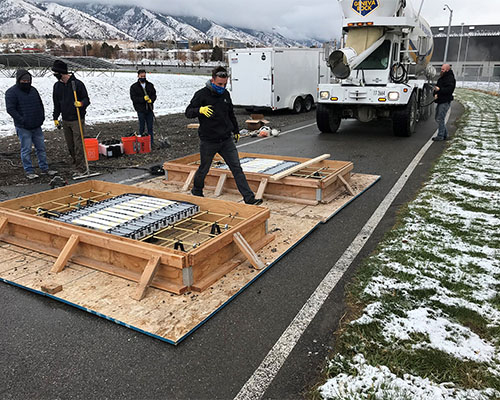Researchers Test Performance of Concrete Panels With Embedded Charging Systems for EVs
Posted: Jun 2, 2025
 Researchers at Utah State University studied the performance of concrete panels with embedded inductive charging systems in early near full-scale testing to learn how the panels performed under thermal stress from the charging system and load stresses from traffic. They found that the thermal strains in the concrete for one or two hours of continuous coil operation did not cause observable damage to the structure. They also found that steel rebar reinforcement, located under the inductive coils, caused increased power losses because the metal interfered with the inductive power transfer system. A panel constructed with glass fiber reinforced polymer rather than rebar did not interfere with power transfer and had a higher flexural load capacity. The researchers used these results to update computer models used for designing concrete panels with embedded power transfer systems. The work is a step toward development of large scale in-motion, inductive power transfer systems embedded in roadways to ensure charge duration and replace stationary charging units for electric vehicles.
Researchers at Utah State University studied the performance of concrete panels with embedded inductive charging systems in early near full-scale testing to learn how the panels performed under thermal stress from the charging system and load stresses from traffic. They found that the thermal strains in the concrete for one or two hours of continuous coil operation did not cause observable damage to the structure. They also found that steel rebar reinforcement, located under the inductive coils, caused increased power losses because the metal interfered with the inductive power transfer system. A panel constructed with glass fiber reinforced polymer rather than rebar did not interfere with power transfer and had a higher flexural load capacity. The researchers used these results to update computer models used for designing concrete panels with embedded power transfer systems. The work is a step toward development of large scale in-motion, inductive power transfer systems embedded in roadways to ensure charge duration and replace stationary charging units for electric vehicles.
Marv Halling, Ph.D.
Utah State University
Pilaiwan Vaikasi, Ph.D.
Former Graduate Research Assistant
Utah State University
Implementation of Precast Concrete Segments for Electrified Roadway
MPC-24-570